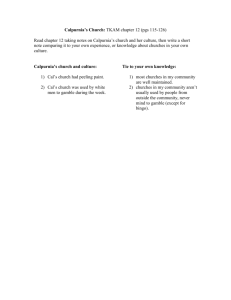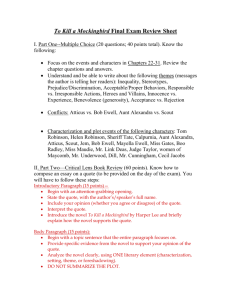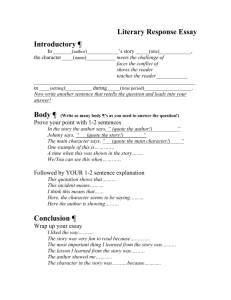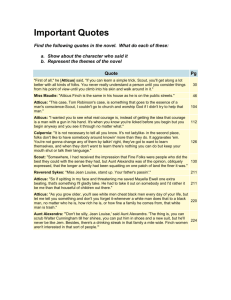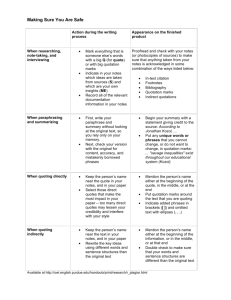I Say, It Says, And So*: Using Evidence in Academic Writing
advertisement
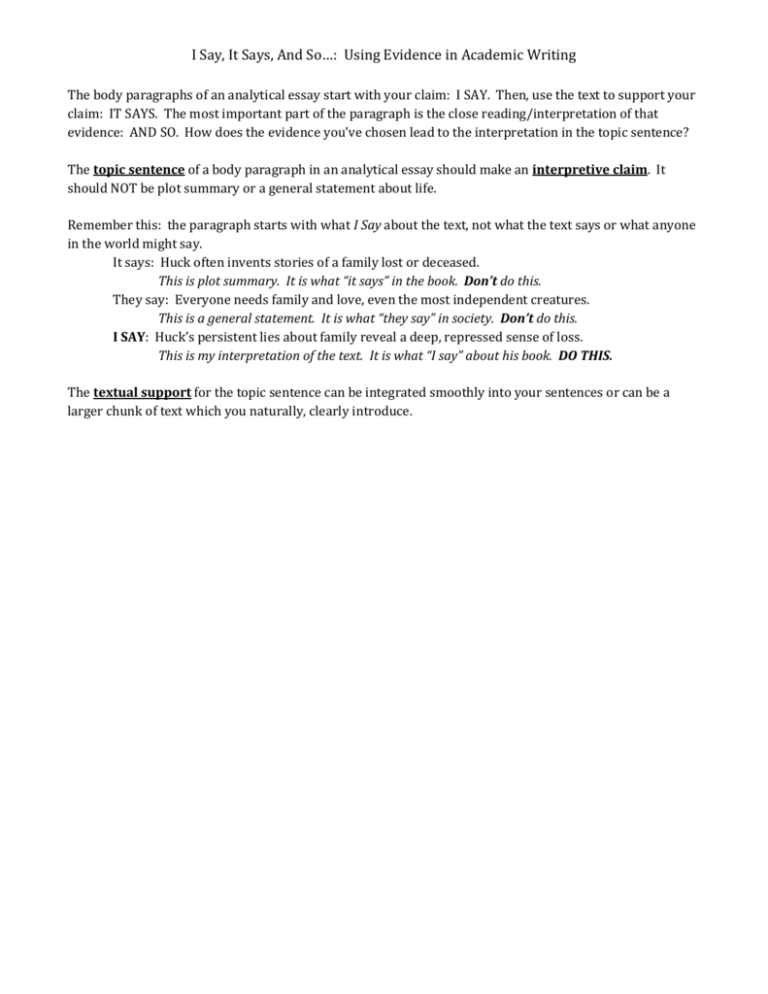
I Say, It Says, And So…: Using Evidence in Academic Writing The body paragraphs of an analytical essay start with your claim: I SAY. Then, use the text to support your claim: IT SAYS. The most important part of the paragraph is the close reading/interpretation of that evidence: AND SO. How does the evidence you’ve chosen lead to the interpretation in the topic sentence? The topic sentence of a body paragraph in an analytical essay should make an interpretive claim. It should NOT be plot summary or a general statement about life. Remember this: the paragraph starts with what I Say about the text, not what the text says or what anyone in the world might say. It says: Huck often invents stories of a family lost or deceased. This is plot summary. It is what “it says” in the book. Don’t do this. They say: Everyone needs family and love, even the most independent creatures. This is a general statement. It is what “they say” in society. Don’t do this. I SAY: Huck’s persistent lies about family reveal a deep, repressed sense of loss. This is my interpretation of the text. It is what “I say” about his book. DO THIS. The textual support for the topic sentence can be integrated smoothly into your sentences or can be a larger chunk of text which you naturally, clearly introduce. I Say, It Says, And So…: Using Evidence in Academic Writing Rules for Using Evidence from the Text: Students often ask, “Do I need direct quotes?” Yes. To make a specific, original claim, you need to show what words or phrases got you thinking. Not using specific support leaves readers often doing summary, not analysis. Do not use the phrases: “in this quote”; “this quote shows”; or “on p.____ it says…” Your job at this stage of the writing game is to be specific and mature. Instead of “this quote shows,” argue specifically about what word or phrase illustrates your point. Setting up a quotation by telling the page is also immature; it assumes your reader has the contents of each page memorized. Do you use a FULL SENTENCE to introduce your quotation, or do you use a PHRASE? IF YOU USE A FULL SENTENCE, put a COLON (:) after the sentence. IF YOU USE A PHRASE, put a COMMA (,) after the phrase. Is there dialogue in the material you’re quoting? If there is DIALOGUE, use two quotation marks to indicate everything you took from the book. Use single quotation marks to show what was already in quotes in the book. Follow the example in the paragraph below. Although Calpurnia is a domestic servant, her role in the Finch family transcends racial boundaries. As Atticus tells Aunt Alexandra, “’I don’t think the children’ve suffered one bit from her having brought them up. If anything, she’s been harder on them in some ways than mother would have been…’” (139). Atticus affirms Cal’s ability to raise the kids not only as a mother would, but also with a sense of right and wrong. Where should page numbers be? Page numbers go in parentheses AFTER the QUOTATION MARKS and BEFORE the PERIOD to end the sentence. Put JUST the NUMBER in parentheses, not “p.” or “pg.” Is the quote shorter than FOUR TYPED LINES? If the quote IS shorter than four typed lines, then the quote is embedded in the text of your paper. Use quotation marks to indicate the author’s words. Follow the example in the paragraph below: Throughout the novel, Calpurnia’s tenderness shows the children, and readers, that whites and blacks feel the same emotions, a necessary foundation for racial reconciliation. As Scout grows older, she begins to appreciate Calpurnia’s commitment to the Finch family, and she feels less antagonistic toward Calpurnia: “Calpurnia bent down and kissed me. I ran along wondering what had come over her. She had wanted to make up with me, that was it” (33). When Cal kisses Scout, she models forgiveness and reconciliation. These emotions will be a vital part of any future progress in the community. The tenderness that I Say, It Says, And So…: Using Evidence in Academic Writing Cal feels for Scout shows Scout that antagonism between the races is not a permanent state of affairs. If the quote IS LONGER than four typed lines, then indent the entire quote. Follow the example in the paragraph below. This is a BLOCK QUOTE. Do NOT use quotation marks around the quote. Only use quotation marks if what you are quoting was dialogue and therefore in quotes in the book. Atticus’s sense of equality is evident in his insistence that Calpurnia be treated not as a servant but as family. When Aunt Alexandra recommends Atticus dismiss Cal, he makes his belief in equality clear: Atticus’s voice was even: “Alexandra, Calpurnia’s not leaving this house until she wants to. You may think otherwise, but I couldn’t have got along without her all these years. She’s a faithful member of this family and you’ll simply have to accept things the way they are. Besides sister, I don’t want you working your head off for us—you’ve no reason to do that. We still need Cal as much as we ever did.” (12) By calling Calpurnia a “faithful member of the family,” Atticus shows that Calpurnia’s relationship to the Finches is not hindered by racial difference. In the Finch household, the idea of accepting “things the way they are” is the exact opposite of what it means to accept the societal status quo. Atticus has created an alternative realm in his household, one in which familial bonds transcend racial lines. Although Atticus pretends to reassure Aunt Alexandra that Calpurnia’s role is one of servant and that Alexandra should not have to work hard in the household, he also insists that he needs Cal. Only a man with such a deeply ingrained sense of justice would call Calpurnia family in this time period.
